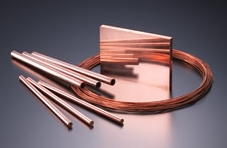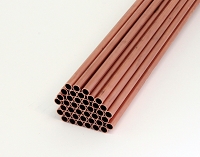Copper
Copper (chemical symbol Cu, atomic number 29)

Features of copper
It is the second most conductive metal after silver and is widely used in electrical products. It is also an extremely good heat conductor and is therefore used in many heat-exchange devices from refrigerators and air conditioners to power and chemical plants. Further, it is light, incombustible, workable and durable. Its greenish-blue color is popular and roofs of European palaces and Japanese temples and shrines have been made of copper for a long time.
Oligodynamic metal action of copper
In extremely small quantities, copper, silver and mercury have powerful anti-bacterial properties and this is known as the oligodynamic action of metal. In reports published by the International Research Committee, copper and copper alloys are indicated as extremely efficient in the prevention of transmission of illness in medical facilities and in recent years many products have been developed that take advantage of the oligodynamic action of copper – it is antibacterial function. Copper sheets are often used in sewage plants for algae control, owing to this oligodynamic action.
Varieties of copper
| Varieties of copper |
||
| Name |
JIS |
Usage |
| Oxygen free copper |
C1020 | Does not cause hydrogen embrittlement. Electric, chemical industry |
| Tough-pitch copper |
C1100 | Electric, buildings, chemical industry, gaskets, containers, automobile parts |
| Phosphorus-deoxidized copper | C1201 C1200 C1221 |
Bath tubs, boilers, gaskets, electric refrigerators, buildings (roofs, gutters), chemical industry, does not cause hydrogen embrittlement. |
Reference: Nihon Shindoh Cooperative – Shindoh Data book.


 HOME
HOME

 Preceding page
Preceding page